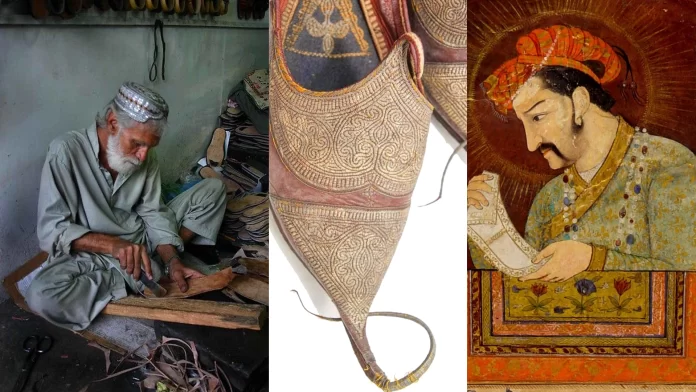Multan, a city renowned for its rich artistic heritage, is home to Okair Sazi, a centuries-old craft of leather ornamentation. This intricate art form, deeply rooted in the cultural fabric of the region, involves embossing leather with gold or silk thread designs derived from meticulously crafted paper cutouts. The practice, initially confined to footwear, has now expanded into a flourishing industry, embellishing items like belts, handbags, and even furniture.
The Origins of Okair Sazi
The term Okair, originating from the Saraiki language, means to emboss, perfectly capturing the essence of this delicate craft. Historically, cobblers in Multan utilized paper stencils to create intricate floral and geometric patterns, which were later overlaid with tilla (golden thread). This unique process allowed for a single-use stencil, ensuring that every design remained exclusive.
While the technique had existed for centuries, it remained a niche skill due to its labor-intensive nature. The ornamentation of a single shoe could take almost a month, making mass production unfeasible. Ustad Saleh Muhammad, a visionary artisan who migrated to Multan in the 1940s, revolutionized this process by introducing paper-cut ornamentation as a commercial craft. His innovations enabled artisans to produce designs at a faster rate, leading to the craft’s widespread adoption.
The Expansion of the Craft
Under Ustad Saleh Muhammad’s leadership, Okair Sazi transformed into a thriving industry, benefiting hundreds of artisans and their families. His method of producing paper-cut patterns instead of directly ornamenting leather allowed for greater efficiency and affordability. As demand surged, skilled artisans, including women, joined the trade, making tilla-embroidered shoes a sought-after fashion statement, even attracting international buyers.
By the 1950s and 60s, Okair Sazi expanded beyond shoes to belts, chairs, tea covers, and handbags. The industry gained further recognition with the first leather ornamentation competition held in Multan in 1985. Innovations, including calligraphy and pictorial designs, added new dimensions to the craft.
A Cultural and Economic Heritage
Today, Multan remains the epicenter of Okair Sazi, preserving a tradition that blends craftsmanship with cultural identity. Despite modern manufacturing techniques, the meticulous handwork and heritage of Okair Sazi continue to thrive. This enduring art form not only supports local artisans but also serves as a symbol of Pakistan’s artistic excellence on the global stage.
As the industry evolves, efforts to document, promote, and innovate Okair Sazi will ensure its survival for generations to come. With continued interest and support, this historic craft can maintain its rightful place in the rich artistic legacy of Multan.





